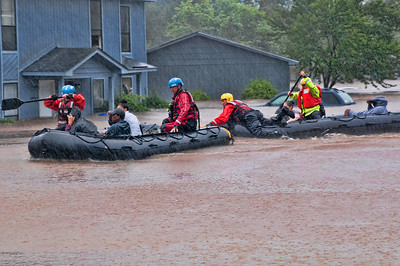
by Elizabeth Kellar, director of public policy, ICMA; senior fellow, Center for State and Local Government Excellence
Responding to disasters on the scale of the hurricane-driven flooding and devastating wildfires that struck Florida, Texas, Puerto Rico, and northern California in recent months is daunting, exhausting, and filled with heroic actions by a multitude of professionals and volunteers.
And yet, even greater heroics may be required to get the long-term recovery right. The same government leaders who have been consumed by the immediate disaster response now need to muster the energy to engage the community and its many stakeholders in conversations about the future. It's always going to be hard to get residents and business leaders to talk about long-term goals at a time when they just want their lives and businesses returned to normal as quickly as possible. But there is no better time to plan how and where to rebuild in a more sustainable way.
Florida, for example, has strict building standards, adopted in the 1990s after Hurricane Andrew, that kept more roofs in place in 2017 in Hurricane Irma's wind gusts than would have been expected had those standards not been in place. Building standards can make a difference in flooding, too. While a typical Texas ranch-style home is built on a concrete slab, those built above a crawl space experienced less flood damage during Hurricane Harvey.
Bigger questions arise when considering how often homes have been rebuilt due to their location on a floodplain. Can the homeowners be bought out and encouraged to rebuild elsewhere? Can a long-term plan be put in place to guide future development? While these are simple questions, there are no easy answers.
In June 2008, Cedar Rapids, Iowa, experienced a devastating flood that displaced 18,000 residents, flooded 5,900 properties, and damaged 310 city facilities. Deciding what to do to make the city more disaster-resilient involved a long community conversation. Ultimately, some 1,400 flood-prone homes were bought and demolished. The city required new buildings to be built above the floodplain, raised all of its sewers, built a levee around its sewage-treatment plant, and moved its central library and a firehouse to higher ground. And the work is not done. The city has a 20-year plan to build a series of levees and floodwalls.
One reason the voluntary buy-out program was successful was that the city offered 110 percent of the pre-flood assessed value of the homes. A related initiative that helped residents get permanent housing and move on with their lives was an interim mortgage assistance program that covered monthly payments on flood-damaged homes until residents could relocate.
I reached out to Cedar Rapids City Manager Jeff Pomeranz to ask what advice he would give to local government leaders facing such massive recovery challenges. "First," he said, "do not underestimate the power of a plan." Cedar Rapids completed a flood control system plan within five months of the 2008 disaster, and that was followed by a neighborhood planning process. The community's shared vision for building stronger led to decisive policy action by elected officials and quick implementation by city staff. The steps taken since 2008 enabled the city to withstand its second-worst flood event last year with virtually no property damage.
"You also need to over-communicate and provide consistent messages," Pomeranz said, adding that it's been important to remind residents frequently why long-term initiatives, such as the 20-year flood-control project, are still critical to the community. Without consistent messaging, a long-term project can lose a sense of urgency and fade behind more immediate needs.
Pomeranz advises communities to be creative not only in finding outside resources but also in using the skill sets of existing city staff. Cedar Rapids, for example, pulled personnel who normally help staff the community's library and used their specific skills and knowledge to assist with the city's significant customer service needs after the 2008 flood.
And finding outside resources to support local government teams that have been working tirelessly for weeks or months in a disaster's aftermath would make it more likely not only that the immediate recovery work will proceed smoothly but also that the important planning and community engagement work can be done thoughtfully. ICMA has long advocated a "city hall in a box" cadre of local government experts from around the country that could be deployed quickly to a community hard hit by a disaster.
Originally appeared in Governing, November 8, 2017.
New, Reduced Membership Dues
A new, reduced dues rate is available for CAOs/ACAOs, along with additional discounts for those in smaller communities, has been implemented. Learn more and be sure to join or renew today!
